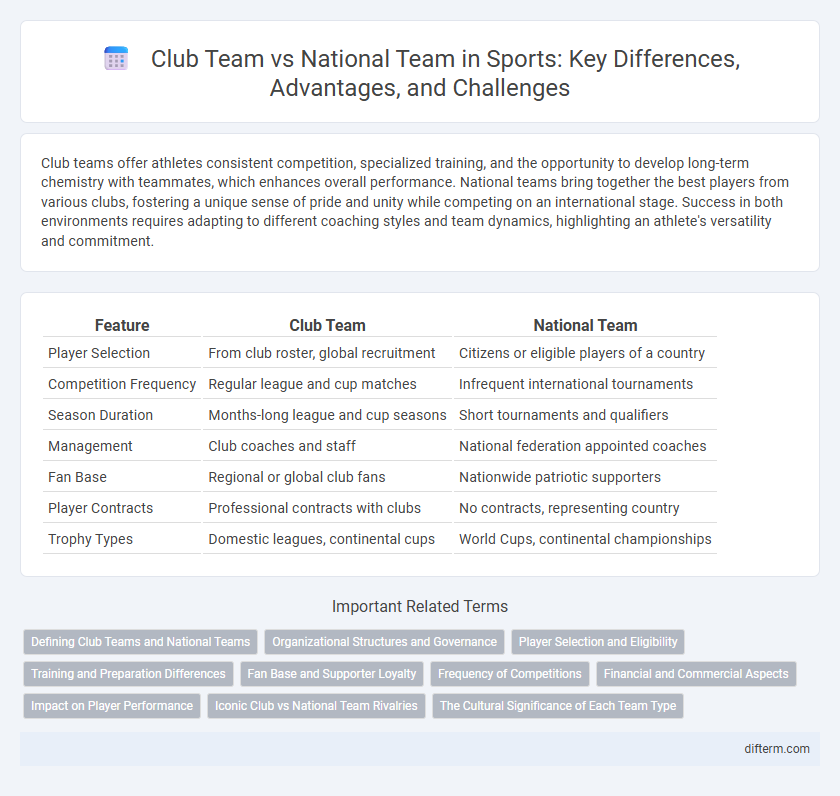Club teams offer athletes consistent competition, specialized training, and the opportunity to develop long-term chemistry with teammates, which enhances overall performance. National teams bring together the best players from various clubs, fostering a unique sense of pride and unity while competing on an international stage. Success in both environments requires adapting to different coaching styles and team dynamics, highlighting an athlete's versatility and commitment.
Table of Comparison
| Feature | Club Team | National Team |
|---|---|---|
| Player Selection | From club roster, global recruitment | Citizens or eligible players of a country |
| Competition Frequency | Regular league and cup matches | Infrequent international tournaments |
| Season Duration | Months-long league and cup seasons | Short tournaments and qualifiers |
| Management | Club coaches and staff | National federation appointed coaches |
| Fan Base | Regional or global club fans | Nationwide patriotic supporters |
| Player Contracts | Professional contracts with clubs | No contracts, representing country |
| Trophy Types | Domestic leagues, continental cups | World Cups, continental championships |
Defining Club Teams and National Teams
Club teams consist of professional athletes contracted to compete in domestic and international leagues, representing specific cities or regions with distinct branding and fan bases. National teams are composed of the best players selected from clubs within a country, representing their nation in international competitions such as the FIFA World Cup or the Olympics. Club teams focus on regular season championships and league success, while national teams emphasize international prestige and national pride.
Organizational Structures and Governance
Club teams operate under private ownership or membership models, with governance typically managed by boards or executives focused on commercial success and long-term player development. National teams are governed by national sports federations affiliated with international bodies such as FIFA or the International Olympic Committee, emphasizing talent selection, national representation, and adherence to regulatory standards. Organizational structures in club teams prioritize competitive league performance and financial sustainability, while national teams focus on strategic alignment with national sports policies and international competition mandates.
Player Selection and Eligibility
Club teams select players based on contracts, scouting, and specific tactical needs, often targeting talent from various nationalities and leagues to build a competitive roster. National teams require players to meet strict eligibility rules defined by governing bodies like FIFA or the IOC, typically based on citizenship, heritage, or residency. Player selection for national teams also considers recent performance, fitness, and commitment to represent their country in international tournaments such as the World Cup or the Olympics.
Training and Preparation Differences
Club teams engage in daily training sessions emphasizing tactical cohesion and long-term fitness tailored to league schedules, enabling continuous skill development and tactical refinement. National teams have condensed training camps focused on quickly building team chemistry and adapting strategies for short international tournaments or qualifiers. The variance in training intensity and duration reflects the differing competitive demands and player availability between club and national setups.
Fan Base and Supporter Loyalty
Club teams typically cultivate stronger local fan bases due to regular matches, community engagement, and player accessibility, boosting supporter loyalty through consistent interaction. National teams, while commanding broad patriotic support during international tournaments, often experience fluctuating fan engagement outside of major events. The emotional investment in club teams is driven by regional identity and long-term commitment, contrasting with the sporadic yet intense national pride that fuels national team fandom.
Frequency of Competitions
Club teams participate in numerous competitions throughout a typical season, including domestic leagues, cup tournaments, and continental championships, often playing multiple matches weekly. National teams, however, compete less frequently, primarily in international tournaments, qualification matches, and friendlies scheduled sporadically across the year. This disparity in competition frequency significantly impacts player workload, team chemistry, and fan engagement at different levels.
Financial and Commercial Aspects
Club teams generate higher revenue through lucrative broadcasting rights, merchandise sales, and sponsorship deals due to their regular season matches and global fan bases. National teams rely heavily on government funding, tournament prize money, and sporadic sponsorships tied to major international competitions like the FIFA World Cup or the Olympics. The financial stability of club teams often surpasses that of national teams, driven by consistent commercial activities and diversified income streams.
Impact on Player Performance
Playing for a club team offers consistent training, tactical familiarity, and regular competitive matches that help players maintain peak physical condition and sharpness. In contrast, representing a national team exposes players to diverse playing styles and high-pressure tournaments, which can enhance adaptability and experience but may also contribute to physical and mental fatigue due to intensified schedules. Balancing the demands of both environments significantly influences overall player performance, development, and career longevity.
Iconic Club vs National Team Rivalries
Iconic club vs national team rivalries, such as FC Barcelona versus Spain, highlight intense debates over player loyalty and tactical superiority. These matchups often showcase star athletes like Lionel Messi or Cristiano Ronaldo representing their clubs against their home countries in international friendlies or testimonial matches. Fans passionately analyze performances, fueling enduring conversations about the true pinnacle of football excellence between club dominance and national pride.
The Cultural Significance of Each Team Type
Club teams symbolize local pride and community identity, fostering deep-rooted fan loyalty and regional traditions that cultivate a shared sense of belonging. National teams represent broader cultural unity and patriotism, uniting diverse populations through collective support and national rituals during international competitions. Both team types play vital roles in shaping societal values, reflecting historical narratives, and promoting cultural heritage within the realm of sports.
club team vs national team Infographic

 difterm.com
difterm.com